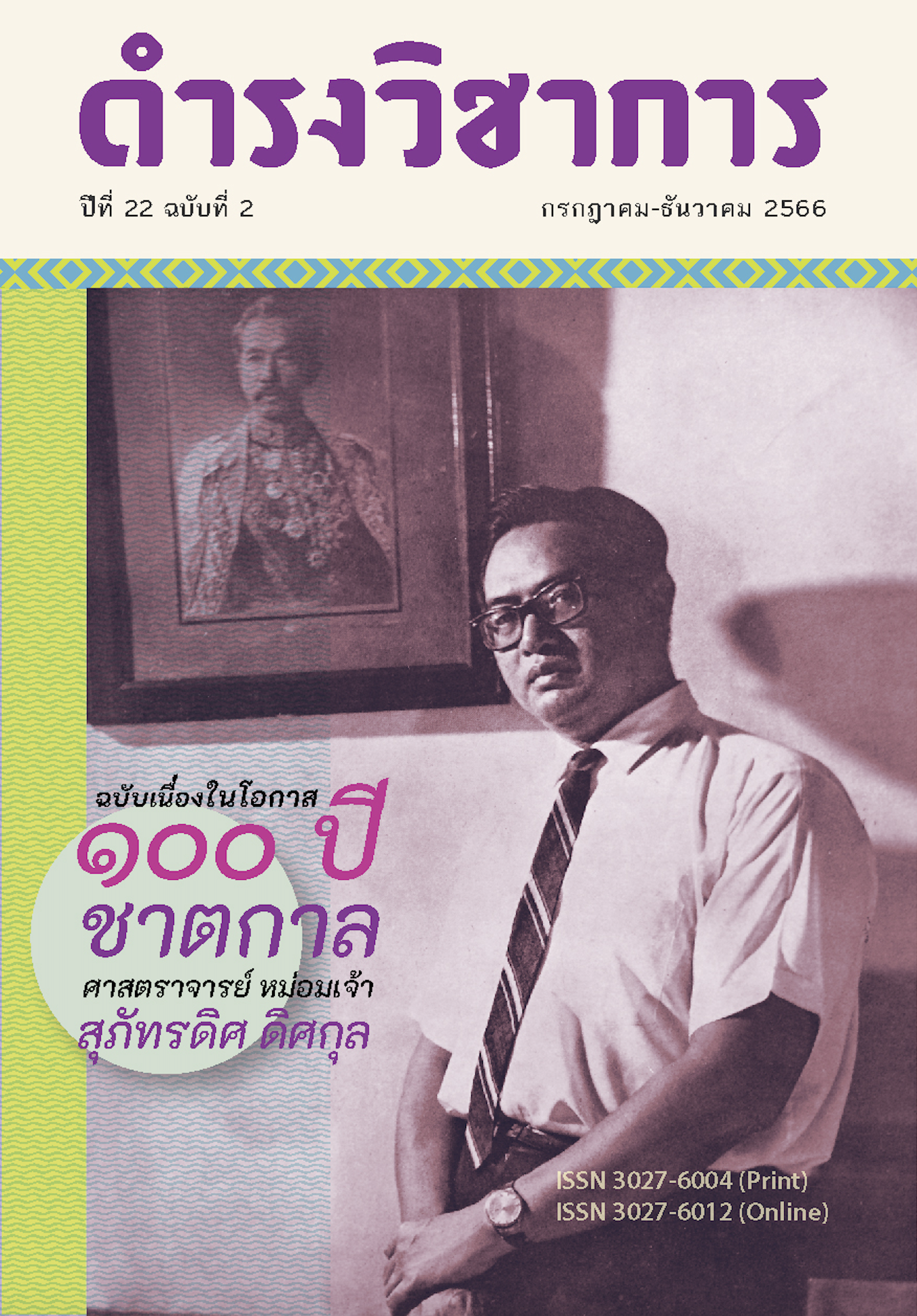Patterns and Origins of Buddha Images in the Early Period of Ban Chang Lo, Bangkok
Keywords:
Ban Chang Lor, Buddha images, FoundryAbstract
In the Rattanakosin era, Ban Chang Lo in the Siri Rat sub-district of Bangkok Noi district was one of the biggest and most significant metal casting communities in Thailand, particularly for Buddha images. The beginnings and origins of Buddha image casting in the Ban Chang Lo have been discussed in several previous works. Therefore, this study uses the art history method, combined with historical documents and interviews with the artisans, to discover the origin, time period, and causes that motivated the craftsmen in Ban Chang Lo to begin casting Buddha statues actively.
The results of the study of 37 floral robe Buddha images with inscriptions and evidence found in Ban Chang Lo are proof that Ban Chang Lo started to cast large amounts of Buddha images from the early 20th century CE onwards. Meanwhile the Royal Foundry, which had done such business before came to a gradual decline in the same time period because of many internal problems. One of the problems is that Mom Chao Suban, the head of the Royal Foundry in the late 19th century, accepted too much work to cast Buddha statues for the commoners that his subordinates felt affected. Therefore, the subordinates escaped to Ban Chang Lo.
For this reason, Ban Chang Lo was influenced by the Buddha image's stylistic characteristics and its casting technique from the Royal Foundry. Additionally, the Lanna Buddha statue, which was popular at the time, also had an impact on the style of the Ban Chang Lo Buddha statue. As a result, the Buddha images created by craftsmen in the Ban Chang Lo have distinctive characteristics of their own.
References
ภาษาไทย
“ข่าวตาย.”, 2428. ราชกิจจานุเบกษา เล่ม 1. ตอนที่ 43 (8 พฤศจิกายน): 385.
“ข่าวสิ้นชีพิตักษัย.”, 2445. ราชกิจจานุเบกษา เล่ม 19. ตอนที่ 25 (21 กันยายน): 502. จุลจอมเกล้าเจ้าอยู่หัว, พระบาทสมเด็จพระ, 2471. พระราชปรารภเรื่องพระพุทธชินราช. พระนคร:โรงพิมพ์พาณิชสรรพอุดม.
___________, 2485. พระราชหัตถเลขา ถึง เจ้าพระยาธรรมาธิกรณาธิบดี (ม.ร.ว. ปุ้ม มาลากุล). พระนคร: โรงพิมพ์ไทยเขษม.
ดำรงราชานุภาพ, สมเด็จพระเจ้าบรมวงศ์เธอ กรมพระยา, 2501. นิทานโบราณคดี. พิมพ์ครั้งที่ 9. กรุงเทพฯ: คลังวิทยา.
___________, 2518. ตำนานพระพุทธเจดีย์. กรุงเทพฯ: คลังวิทยา.
ธวัชชัย ปุณณลิมปกุล, 2551. ช่างไทย สิบหมู่. กรุงเทพฯ: สำนักช่างสิบหมู่ กรมศิลปากร.
นริศรานุวัดติวงศ์, สมเด็จฯ เจ้าฟ้ากรมพระยา และ ดำรงราชานุภาพ, สมเด็จพระเจ้าบรมวงศ์เธอ กรมพระยา, 2505ก. สาส์นสมเด็จ เล่ม 12 ลายพระหัตถ์สมเด็จพระเจ้าบรมวงศ์เธอ เจ้าฟ้ากรมพระยานริศนานุวัดติวงศ์ และสมเด็จพระเจ้าบรมวงศ์เธอ กรมพระยาดำรงราชานุภาพ. ม.ป.ท.: องค์การค้าคุรุสภา.
___________, 2505ข. สาส์นสมเด็จ เล่ม 21 ลายพระหัตถ์สมเด็จพระเจ้าบรมวงศ์เธอ เจ้าฟ้ากรมพระยานริศนานุวัดติวงศ์ และสมเด็จพระเจ้าบรมวงศ์เธอ กรมพระยาดำรงราชานุภาพ. ม.ป.ท.: โรงพิมพ์คุรุสภา.“เรื่องราว เรื่องกรมช่างหล่อซ้ายขวากล่าวโทษหม่อมเจ้าสุบรรณ ว่าทำการอุบาทว์ต่าง ๆ.”, ร.ศ. 116. 7 ธันวาคม ร.ศ. 116. ร.5 ย.12 /138 (รหัสไมโครฟิล์ม มร.5 ย/6). หอจดหมายเหตุแห่งชาติ.
ศักดิ์ชัย สายสิงห์, 2556. พระพุทธรูปในประเทศไทย: รูปแบบ พัฒนาการและความเชื่อของคนไทย. กรุงเทพฯ: ภาควิชาประวัติศาสตร์ศิลปะ คณะโบราณคดี มหาวิทยาลัยศิลปากร.
สารบาญชี ส่วนที่ 1 คือตำแหน่งราชการ สำหรับเจ้าพนักงานกรมไปรษณีย์กรุงเทพมหานคร เล่มที่ 1,2541. กรุงเทพฯ: ต้นฉบับ.
สารบาญชี ส่วนที่ 2 คือราษฎรในจังหวัด ถนน แล ตรอก สำหรับเจ้าพนักงานกรมไปรษณีย์ กรุงเทพมหานคร เล่มที่ 2. 2541. กรุงเทพฯ: ต้นฉบับ.
สารบาญชี ส่วนที่ 3 คือราษฎรในจังหวัดบ้าน หมู่ และลำน้ำ สำหรับเจ้าพนักงานกรมไปรษณีย์ กรุงเทพมหานคร เล่มที่ 3. 2426. พระนคร: บ้านปรัดเล.
“สำหรับตัวเรื่องทูตญี่ปุ่นที่เข้ามารับพระสรีระธาตุ และขอต้นโพธิ์.”, 2443. เอกสารรัชกาลที่ 5 กระทรวงศึกษาธิการ. ร.5 ศ.11-13. หอจดหมายเหตุแห่งชาติ.
สุจิตต์ วงษ์เทศ และคณะ, 2545. เวียงวังฝั่งธนฯ ชุมชนชาวสยาม. กรุงเทพฯ: มติชน.
ข้อมูลอิเล็กทรอนิกส์
ณัฐวิทย์ พิมพ์ทอง, 2560. สืบค้นย่านบางกอกน้อยที่สูญหายด้วยการท่องเที่ยวภาคประชาชน. ค้นเมื่อ 5
มกราคม 2565, จาก https://lek-prapai.org/home/view.php?id=5302.
ข้อมูลสัมภาษณ์
ถนอม บรรณประเสริฐ, 2563. ผู้ดำเนินการโครงการฟื้นฟูงานสร้างพระพุทธรูปทรงเครื่องต้นอย่างพระมหา
จักรพรรดิของบ้านช่างหล่อ. สัมภาษณ์, 7 ธันวาคม.
วันทนา ทิมขำ, 2564. อดีตประธานชุมชนซอยบ้านช่างหล่อ. สัมภาษณ์, 8 มีนาคม.
สุรพันธุ์ อติชาตนันท์, 2563. เจ้าของโรงหล่อพัฒนช่าง บ้านช่างหล่อ กรุงเทพฯ. สัมภาษณ์, 7 ธันวาคม.
Downloads
Published
Issue
Section
License
Copyright (c) 2023 Damrong Journal of The Faculty of Archaeology Silpakorn University

This work is licensed under a Creative Commons Attribution-NonCommercial-NoDerivatives 4.0 International License.
บทความนี้เป็นผลงานของข้าพเจ้าแต่เพียงผู้เดียว และ/หรือเป็นผลงานของข้าพเจ้าและผู้ร่วมงาน ตามชื่อที่ระบุในบทความจริง และเป็นผลงานที่มิได้ถูกนำเสนอหรือตีพิมพ์ที่ใดมาก่อน


